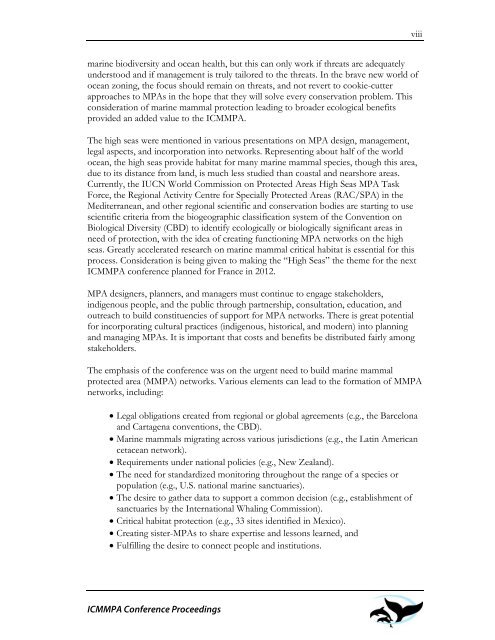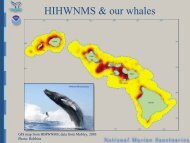The First International Conference on Marine Mammal Protected Areas
The First International Conference on Marine Mammal Protected Areas
The First International Conference on Marine Mammal Protected Areas
Create successful ePaper yourself
Turn your PDF publications into a flip-book with our unique Google optimized e-Paper software.
marine biodiversity and ocean health, but this can <strong>on</strong>ly work if threats are adequately<br />
understood and if management is truly tailored to the threats. In the brave new world of<br />
ocean z<strong>on</strong>ing, the focus should remain <strong>on</strong> threats, and not revert to cookie-cutter<br />
approaches to MPAs in the hope that they will solve every c<strong>on</strong>servati<strong>on</strong> problem. This<br />
c<strong>on</strong>siderati<strong>on</strong> of marine mammal protecti<strong>on</strong> leading to broader ecological benefits<br />
provided an added value to the ICMMPA.<br />
<str<strong>on</strong>g>The</str<strong>on</strong>g> high seas were menti<strong>on</strong>ed in various presentati<strong>on</strong>s <strong>on</strong> MPA design, management,<br />
legal aspects, and incorporati<strong>on</strong> into networks. Representing about half of the world<br />
ocean, the high seas provide habitat for many marine mammal species, though this area,<br />
due to its distance from land, is much less studied than coastal and nearshore areas.<br />
Currently, the IUCN World Commissi<strong>on</strong> <strong>on</strong> <strong>Protected</strong> <strong>Areas</strong> High Seas MPA Task<br />
Force, the Regi<strong>on</strong>al Activity Centre for Specially <strong>Protected</strong> <strong>Areas</strong> (RAC/SPA) in the<br />
Mediterranean, and other regi<strong>on</strong>al scientific and c<strong>on</strong>servati<strong>on</strong> bodies are starting to use<br />
scientific criteria from the biogeographic classificati<strong>on</strong> system of the C<strong>on</strong>venti<strong>on</strong> <strong>on</strong><br />
Biological Diversity (CBD) to identify ecologically or biologically significant areas in<br />
need of protecti<strong>on</strong>, with the idea of creating functi<strong>on</strong>ing MPA networks <strong>on</strong> the high<br />
seas. Greatly accelerated research <strong>on</strong> marine mammal critical habitat is essential for this<br />
process. C<strong>on</strong>siderati<strong>on</strong> is being given to making the “High Seas” the theme for the next<br />
ICMMPA c<strong>on</strong>ference planned for France in 2012.<br />
MPA designers, planners, and managers must c<strong>on</strong>tinue to engage stakeholders,<br />
indigenous people, and the public through partnership, c<strong>on</strong>sultati<strong>on</strong>, educati<strong>on</strong>, and<br />
outreach to build c<strong>on</strong>stituencies of support for MPA networks. <str<strong>on</strong>g>The</str<strong>on</strong>g>re is great potential<br />
for incorporating cultural practices (indigenous, historical, and modern) into planning<br />
and managing MPAs. It is important that costs and benefits be distributed fairly am<strong>on</strong>g<br />
stakeholders.<br />
<str<strong>on</strong>g>The</str<strong>on</strong>g> emphasis of the c<strong>on</strong>ference was <strong>on</strong> the urgent need to build marine mammal<br />
protected area (MMPA) networks. Various elements can lead to the formati<strong>on</strong> of MMPA<br />
networks, including:<br />
• Legal obligati<strong>on</strong>s created from regi<strong>on</strong>al or global agreements (e.g., the Barcel<strong>on</strong>a<br />
and Cartagena c<strong>on</strong>venti<strong>on</strong>s, the CBD).<br />
• <strong>Marine</strong> mammals migrating across various jurisdicti<strong>on</strong>s (e.g., the Latin American<br />
cetacean network).<br />
• Requirements under nati<strong>on</strong>al policies (e.g., New Zealand).<br />
• <str<strong>on</strong>g>The</str<strong>on</strong>g> need for standardized m<strong>on</strong>itoring throughout the range of a species or<br />
populati<strong>on</strong> (e.g., U.S. nati<strong>on</strong>al marine sanctuaries).<br />
• <str<strong>on</strong>g>The</str<strong>on</strong>g> desire to gather data to support a comm<strong>on</strong> decisi<strong>on</strong> (e.g., establishment of<br />
sanctuaries by the <str<strong>on</strong>g>Internati<strong>on</strong>al</str<strong>on</strong>g> Whaling Commissi<strong>on</strong>).<br />
• Critical habitat protecti<strong>on</strong> (e.g., 33 sites identified in Mexico).<br />
• Creating sister-MPAs to share expertise and less<strong>on</strong>s learned, and<br />
• Fulfilling the desire to c<strong>on</strong>nect people and instituti<strong>on</strong>s.<br />
ICMMPA <str<strong>on</strong>g>C<strong>on</strong>ference</str<strong>on</strong>g> Proceedings<br />
viii



